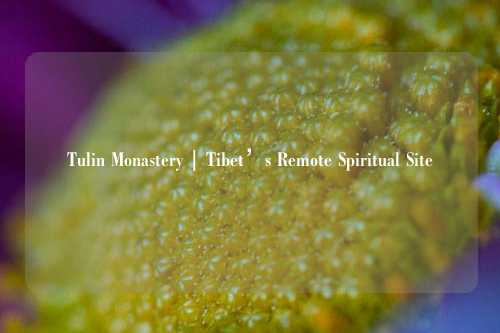Tulin Monastery | Tibet’s Remote Spiritual Site
Tulin Monastery stands as a testament to the enduring spiritual traditions of Tibet, perched in a secluded corner of the plateau where faith and devotion have flourished for centuries. The site, surrounded by rugged mountains and expansive valleys, offers a glimpse into a way of life shaped by Buddhist teachings, monastic discipline, and an unbreakable connection to the land.
A Sanctuary of Tibetan Buddhism
Tulin Monastery has long served as a refuge for monks and scholars seeking enlightenment through meditation, scripture study, and ritual practice. Established centuries ago, the monastery follows the principles of Tibetan Buddhism, incorporating elements of philosophy, sacred art, and ceremonial customs that have been passed down through generations.

The monastery’s architectural style reflects a harmonious blend of religious symbolism and regional craftsmanship. Whitewashed walls, tiered roofs adorned with golden ornaments, and intricately painted murals create a visually striking setting. Prayer flags flutter in the wind, carrying mantras across the landscape, while the sound of chanting and the steady rhythm of the prayer wheel rotations fill the air.
The Sacred Rituals and Practices
Daily life at Tulin Monastery revolves around a strict schedule of prayers, teachings, and rituals. Monks gather in the assembly hall to recite scriptures, accompanied by the deep resonance of horns and drums. Meditation sessions, held in dimly lit chambers, provide an opportunity for introspection and spiritual growth.
A significant practice within the monastery is the creation of sand mandalas, intricate geometric designs made from colored sand. These artworks, meticulously crafted over days or even weeks, represent the impermanence of life. Once completed, the mandala is ceremoniously dismantled, with the sand dispersed into a nearby river as a symbolic gesture of non-attachment.
Another important ritual is the Cham dance, a sacred performance featuring masked dancers who embody deities, protectors, and historical figures. Accompanied by rhythmic drumming and cymbals, this dance serves as both a form of meditation and a means of storytelling, conveying moral lessons and spiritual wisdom.
The Library and Ancient Manuscripts
Tulin Monastery houses an extensive collection of Buddhist scriptures, including rare manuscripts written on hand-pressed paper using mineral-based inks. These texts, safeguarded within the monastery’s library, cover a wide range of topics, from philosophy and medicine to astronomy and poetry.
The preservation of these ancient writings is a priority for the monks, who dedicate themselves to studying and transcribing the texts to ensure that the knowledge is passed down. Some manuscripts are adorned with elaborate illustrations depicting scenes from Buddhist teachings, celestial beings, and sacred symbols.
Pilgrimage and Devotional Journeys
For centuries, pilgrims have journeyed across vast distances to reach Tulin Monastery, seeking blessings, spiritual guidance, or the fulfillment of personal vows. Many travelers undertake the kora, a ritual circumambulation of the monastery, walking clockwise while spinning prayer wheels and murmuring mantras.
Some devotees carry out full-body prostrations along the pilgrimage route, touching their foreheads to the ground in a gesture of humility and devotion. This physically demanding practice reflects a deep commitment to faith, with each step taken as an act of purification.
The monastery is also an important stop along a broader network of sacred sites in Tibet. Pilgrims often combine their visit to Tulin with journeys to nearby holy mountains, lakes, and meditation caves associated with revered spiritual figures.
The Natural Landscape and Spiritual Solitude
The remote location of Tulin Monastery adds to its spiritual significance. Nestled within a valley framed by snow-capped peaks, the monastery is surrounded by an environment that encourages reflection and contemplation. The high-altitude air is crisp and clear, and the vast openness of the plateau fosters a sense of detachment from worldly distractions.
Wildlife flourishes in the surrounding terrain, with herds of yaks grazing on the slopes and eagles soaring overhead. The region’s flora, including hardy shrubs and medicinal plants, has been used by monks for centuries in the preparation of herbal remedies and spiritual offerings.
During sunrise and sunset, the landscape takes on a surreal beauty, with golden light casting long shadows across the monastery walls. These quiet moments, undisturbed by modern influences, allow visitors to immerse themselves fully in the sacred atmosphere.
Festivals and Community Gatherings
Throughout the year, Tulin Monastery hosts various religious festivals, drawing monks, pilgrims, and local communities together for celebrations marked by prayer, music, and traditional ceremonies.
One of the most significant events is the Great Prayer Festival, during which monks engage in extended periods of chanting and philosophical debates. These debates, characterized by animated gestures and rapid exchanges of logic, serve as a means of refining understanding and deepening spiritual insight.
Losar, the Tibetan New Year, is another major celebration. The monastery becomes a focal point for festive activities, including the preparation of special dishes, the offering of butter sculptures, and the lighting of ritual lamps. Families and pilgrims gather to seek blessings for the year ahead, reinforcing the strong communal bonds that define Tibetan society.
The Role of Tulin Monastery in Modern Tibet
While maintaining its centuries-old traditions, Tulin Monastery has also adapted to changing times. Efforts to preserve monastic education continue, with younger monks receiving instruction in classical Buddhist texts as well as Tibetan language, calligraphy, and meditation techniques.
Visitors, both domestic and international, have shown increasing interest in learning about Tibetan Buddhism, prompting the monastery to welcome those who seek spiritual retreats or wish to engage in meditation workshops. This openness allows for cultural exchange while ensuring that the monastery remains a place of deep spiritual practice.
Despite its isolated setting, Tulin Monastery remains an enduring symbol of faith, knowledge, and resilience. Its presence on the Tibetan plateau serves as a reminder of the profound spiritual heritage that continues to inspire seekers from all walks of life.
















